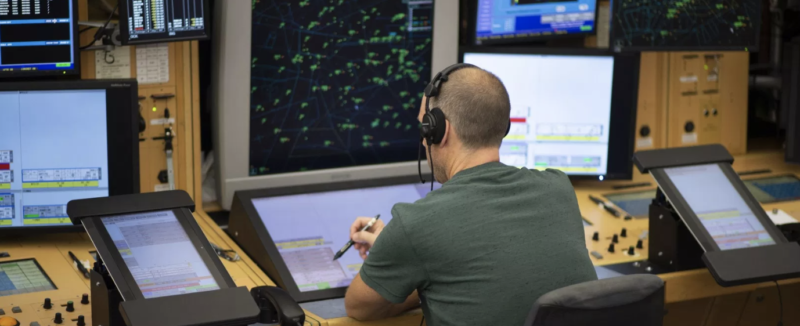Airspace Infringement Series: A controller’s story…
12 April 2019Brian Ringrose, an air traffic controller at Swanwick centre looking after airspace around Gatwick, talks about his experience with airspace infringements for this week’s Infringement Series case study…
One day, while on a shift, I noticed a primary radar contact enter my sector travelling in a south easterly direction. The contact continued to track south east through my airspace (fortunately away from the airport) but was still a problem for any potential missed approach. I phoned the tower and asked them if they could see anything, but initially the answer was negative.
I continued working my inbounds keeping one eye on the primary contact but a few minutes later the tower called me to say they were visual with the aircraft and it looked quite high, certainly above the confines of the control zone (2500ft).
At this point, I called one of my colleagues back from their rest break because I knew my workload was going to dramatically increase while I tried to avoid the unknown aircraft making contact with my traffic.
“I knew my workload was going to dramatically increase while I tried to avoid the unknown aircraft”
We need to keep IFR (Instrument Flight Rules) traffic at least three miles (or three thousand feet) away from infringing traffic, so I put some inbound aircraft into the holds and waited for my colleague to arrive to split and share the sector. This gave me additional capacity to deal with the traffic and make any phone calls to help manage the situation.
I was now concerned that I may have already had multiple separation losses prior to becoming aware of the infringing traffic. Without the aircraft having SSR and Mode C I wouldn’t have had any idea the aircraft was inside controlled airspace.
I continued tracking the infringing aircraft until my information showed it had left controlled airspace to the south of the airfield. It was at this point one of our routine helicopters called on the frequency for a VFR zone transit. I gave them a clearance which was safe and separated from the IFR inbounds, but then the infringer did an almost ninety degree turn heading back into controlled airspace. I informed the helicopter of the situation and passed traffic information.
“I could have put a commercial airliner in conflict with the infringer at the same level without any safety net”
I informed the helicopter pilot and asked them to pass on any information they could cipher about the other traffic. It’s never comfortable passing traffic on reciprocal tracks and saying the words “traffic is now 2 miles opposite direction, unknown level”.
It was at this point that the helicopter pilot told me they had sight of the infringing aircraft but that it was flying significantly above them. The helicopter pilot very kindly offered to continue maintaining his own separation to obtain more information about the infringer for me. They soon provided me with identifying marks, the infringer’s registration and, most crucially, an approximate altitude.
“it really struck me the potential for what could have happened.”
We have a tool on radar called CAIT (Controlled Airspace Infringement Tool) which points out primary and secondary radar contacts that are potentially infringing. The problem with primary, as we have no height information, is that it assumes they are underneath controlled airspace. There is an area on final approach where the airspace starts from 1500ft so it assumes the contact is therefore beneath that level.
Without the information given to me by the helicopter we would never have known the level of the unknown aircraft. Quite legitimately and inadvertently I could have put a commercial airliner in conflict with the infringer at the same level without any safety net. I continued to keep my traffic well away from the contact and tracked its progress until well clear of the confines of controlled airspace.
I was relieved from position and started the process of reporting the incident. I had time to reflect on this event and it really struck me the potential for what could have happened and how thankful I was for the helicopter pilot calling at the time they did and the assistance they gave.
According to the Civil Aviation Authority, in 2018 there were a total of 1,358 reported airspace infringements. Analysis of reports from 2017 has shown that:
- The correct use of a moving map with alert could have prevented 85% of infringements
- Using an frequency monitoring code (Listening Squawk) could have prevented 65% of infringements
- Recognition of/dealing with overload, fixation and distraction – possibly effective in 43% of cases
- Better familiarity with aircraft and equipment – possibly effective in 24% of cases
Pilots are encouraged to request entry into controlled airspace as early as possible, either by free call, radio transmission or our Airspace Users Portal.
Via the portal, https://aup.nats.aero/, pilots can submit a CAS request before their intended crossing so our controllers can prepare for their arrival – helping pilots with their requests and enabling safer use of the airspace.
Comments
Please respect our commenting policy and guidelines when posting on this website.

23.04.2019
16:14
Steve B.
Hello, could you please tell me on which report from 2017 it is written that FMC/Listening squawks could have prevented 65% of infrigments? I am currently doing a research work regarding this topic and I found those number very interesting. Thank you so much !
26.04.2019
10:57
Brian Ringrose
Hi Steve – the CAA analysis can be found online here https://airspacesafety.com/wp-content/uploads/2019/01/CausalFactorAnalysisofAirspaceIInfringements.pdf
10:57
Brian Ringrose